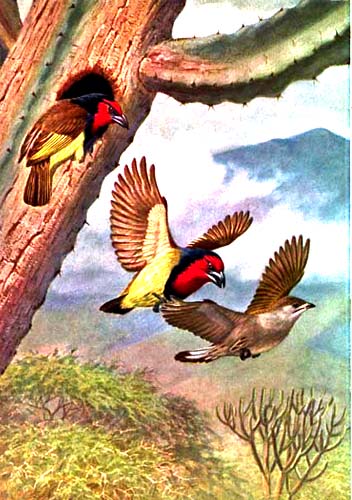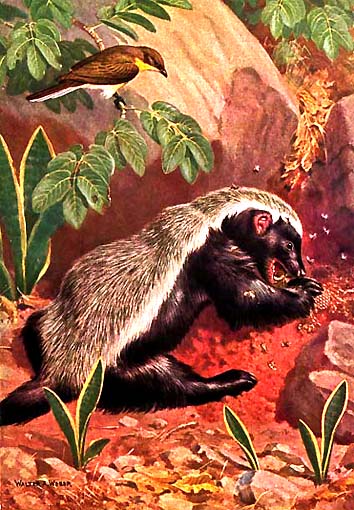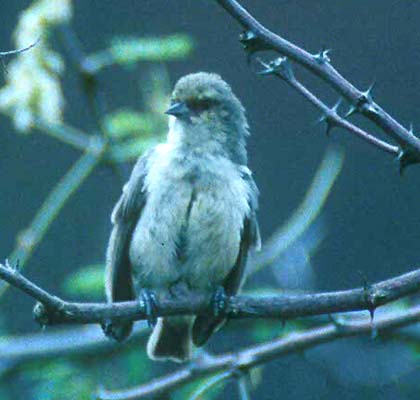 The Honeyguides are a fairly small Old World family of dull-plumaged, parasitic
passerine-appearing birds that are, in fact, related to woodpeckers and
barbets. Although they do have male courtship songs and aerial display,
they are not passerines at all. Equally interesting, they are (as far as
is known) entirely parasitic, laying their eggs in the nests of other hole-nesting
species, and especially in the nests of small barbets and tinkerbirds.
The Honeyguides are a fairly small Old World family of dull-plumaged, parasitic
passerine-appearing birds that are, in fact, related to woodpeckers and
barbets. Although they do have male courtship songs and aerial display,
they are not passerines at all. Equally interesting, they are (as far as
is known) entirely parasitic, laying their eggs in the nests of other hole-nesting
species, and especially in the nests of small barbets and tinkerbirds.
During my childhood in the 1950s and early 1960s, my family subscribed to National Geographic magazine. I was thus very familiar with the work of Walter A. Weber, National Geographic's staff artist. The April 1954 issue featured five color plates of the honeyguides, all of which were reproduced in Friedmann's (1955) monograph on the family. These are among my favorite bird paintings. In Walter A. Weber's painting (left), a pair of of Black-collared Barbets Lybius torquatus chase a Lesser Honeyguide from their nest hole in a dry country cacti. These social barbets are among the species most commonly parasitized by Lesser Honeyguide (Short & Horne 2002), so the painting captures both the interaction and the open arid land habitat very well. [The thick forest on the mountain in the background may contain Thick-billed Honeyguide Indicator conirostris; the two nearly identical species separate out ecologically here in east Africa.] There are two tribes in this family: the basic honeyguides (14 species) and the thin-billed honeybirds (3 species). I have not yet managed to get a decent photo of any of them, but my friend Ed Harper has nicely photographed the Eastern Honeybird (below) in Kenya. |
| One point illustrated nicely by both Weber's art and Harper's photo
is the drab grayish or olive plumage worn by these birds. This — and their
often retiring behavior — can make them difficult to locate and then, once
found, difficult to identify. About the only distinctive features are a
dark malar stripe (on some species) and white in the outer rectrices (all
species). In all the typical honeyguides the white outer tail feathers
are either very short or are tipped dark, producing a distinctive white
wedge in the tail (shown in the artwork on the flying Lesser Honeyguide.
In two of the honeybirds, including the Eastern (above), the outer rectrices
are entirely white without dark tipping.
The white tail patches are important in honeyguide biology. All species of honeyguide — the 15 in Africa and 2 in Asia — eat beeswax and honeycomb. The flashing white tail patches stimulates young honeyguides to follow others to bee-hives in the woods, and, as the feature is more visible in immatures. also serves to establish immature honeyguides as dominant when at the wax sources. In parts of Africa, humans follow "guide" birds to these honeycombs. The birds benefit when men break open the beehives to get the honey, and people benefit from following the birds to the hives. Some "guide" birds give distinctive chipping notes to encourage men to follow them to the hives, yet there are other parts of Africa where this does not happen at all (Short & Horne 2002).
|
 One of the most fabled interrelations between animals is the honeyguide
following a Ratel (or Honey-Badger Mellivora capensis) to beehives.
This Walter A. Weber painting (left) shows a young Greater
Honeyguide above a Ratel tearing apart the honeycomb. The artist got
the bird facts just right: this is a yellow-throated youngster (dominant
at wax sources) rather than a black-throated adult male or a plain-throated
adult female. It is said that Greater Honeyguides "lead" Ratels to the
beehives so that the large mammal can open those hives up. But how much
of this story is true is uncertain. Friedmann (1955) writes:
One of the most fabled interrelations between animals is the honeyguide
following a Ratel (or Honey-Badger Mellivora capensis) to beehives.
This Walter A. Weber painting (left) shows a young Greater
Honeyguide above a Ratel tearing apart the honeycomb. The artist got
the bird facts just right: this is a yellow-throated youngster (dominant
at wax sources) rather than a black-throated adult male or a plain-throated
adult female. It is said that Greater Honeyguides "lead" Ratels to the
beehives so that the large mammal can open those hives up. But how much
of this story is true is uncertain. Friedmann (1955) writes:
"Many authors have written that the ratel or honey-badger is the original associate of the honey-guide in these quests for bees' nests, and that the native (and, from them, Europeans) have stumbled onto the advantage of following the birds from seeing ratels doing so. However, in spite of the vividness and elaboration of some of these descriptions, none of the writers seems actually to have witnessed the association between the honey-guide and the ratel, but all have, often unwittingly, based their accounts on those of earlier writers, the eventual source for all of them being Sparrman (1785), who appears to have received his data from the natives and not from personal observation."As recently as Short & Horne (2002) say: "Although this [honeyguide leading ratel to bees' wax] remains a real possibility, there appears to be little real evidence to support such claims. Clearly, this is one aspect of the honeyguide's behavior that requires further research, along with investigations into whether species other than Greater Honeyguide lead humans in a similar way." Although there is still much to be learned about honeyguides, it is known that small species often eat wax at the entrance to bees' hives early in the morning, while the honey-bees are still lethargic, and that most species supplement their waxy diet with insects taken by fly-catching, and with the odd fruit or berry. Some species also follow woodpeckers around to snatch insects they flush up. The interaction with hosts is also a source of fascination. The Dwarf Honeyguide Indicator pumilio is a tiny species that is endemic to the Albertine Rift Mountains on the border of Congo, Rwanda, and Uganda. Very little is known about it. While birding in Bwindi-Impenetrable Forest Park with local guide Alfred, he played the callnotes of another localized bird, the Western Green Tinkerbird Pogoniulus coryphaeus (which I also wanted to see). As it turned out, this was not so much in hopes of attracting the tinkerbird as in hopes of attracting the honeyguide.... and it worked! A pair of Dwarf Honeyguides approached us very closely in response to the tape. Clearly, they were hoping to find a nest in which to dump some of their eggs. They were so close that I pointed my camera at them and thought I took pictures.... but I can't seem to find those shots, so maybe they were hopelessly dark. But it was an interesting and unexpected relationship. Short & Horne (2002) state that the "eggs and hosts unknown, probably parasitizes tinkerbirds or small woodpeckers," but I think we now can all state, with a reasonably high degree of accuracy, what one of those hosts is. |

 The
most distinctive tail belong to the Lyre-tailed Honeyguide (W.A.
Weber painting, right) of the deep forests of the Congo Basin. Males
give incredible aerial displays in "bouncing ball steps" from high in the
sky down to the forest canopy (thus like a ball bounding down steps), and
at each steps the air rushing through the spread tail produces a booming
kwa-ba
sound that can be heard for a mile. It is extremely hard to see the displaying
bird although the loud sound is characteristic of lowland jungles full
of gorillas and chimpanzees. It is well-nigh impossible to see it from
inside the forest; one must be on the edge (as were Rita and I when we
watched a displaying bird in La Lopé reserve, Gabon. Because this
display is so impressive and so unexpected in a drab little bird, and the
bird itself so hard to see, I have chosen it as among the
The
most distinctive tail belong to the Lyre-tailed Honeyguide (W.A.
Weber painting, right) of the deep forests of the Congo Basin. Males
give incredible aerial displays in "bouncing ball steps" from high in the
sky down to the forest canopy (thus like a ball bounding down steps), and
at each steps the air rushing through the spread tail produces a booming
kwa-ba
sound that can be heard for a mile. It is extremely hard to see the displaying
bird although the loud sound is characteristic of lowland jungles full
of gorillas and chimpanzees. It is well-nigh impossible to see it from
inside the forest; one must be on the edge (as were Rita and I when we
watched a displaying bird in La Lopé reserve, Gabon. Because this
display is so impressive and so unexpected in a drab little bird, and the
bird itself so hard to see, I have chosen it as among the